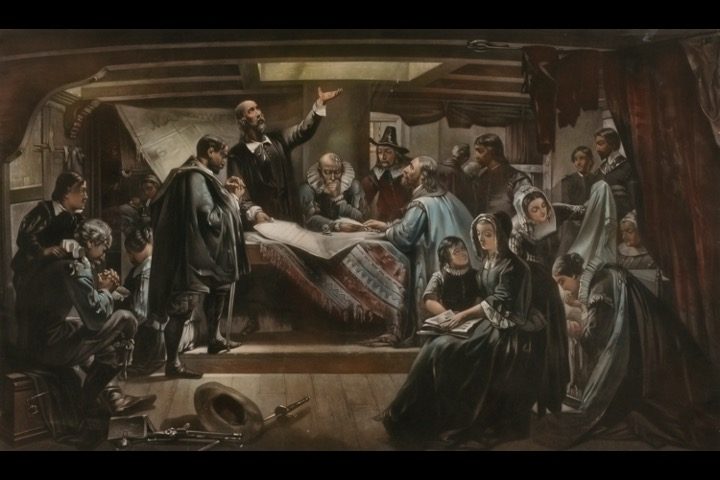
The signing of the Mayflower Compact on November 11, 1620, is a landmark moment in American history, symbolizing the birth of equality and popular sovereignty in the New World.
During King James I’s reign, opposing the Church of England was illegal, and the king, intolerant of any challenge to his authority, preferred to rid his realm of dissenters rather than permit any threat to the state religion he led. To impose his autocratic rule, James dispatched agents throughout the nation to capture Separatists secretly congregating in small groups to evade the king’s loyal spies.
Fearing imprisonment or worse at the hands of the royal agents, 400 English Separatists fled their beloved England. They sailed surreptitiously to Holland (leaving England without permission was a crime), where the atmosphere was more accommodating to those given to alternative (read: unofficial) interpretations of the Word of God. The Dutch were historically more tolerant of religious dissidents and would permit, within limits, pilgrims of many religious creeds to assemble without fear of reprisal or persecution.
Although the Pilgrims found a welcoming harbor in Holland, it proved to be a brief respite, as political situations altered as crucial peace treaties with Spain and France expired, leaving Holland politically unallied and therefore exposed to the avarice of other less-progressive states.
As the climate in Holland became decreasingly hospitable, the Pilgrims met to formulate a new plan and consider the options open to them. It was decided that, despite the possible implications, they would return to England, and they immediately set about acquiring investors to fund their ultimate journey: to America. The Pilgrim pastors believed unwaveringly that God’s will was manifest in their wanderings and privations, just as it had been with the Children of Israel in Egypt. After 40 years, the Israelites crossed over the Jordan and entered the Holy Land, a land promised to them by their God and his prophets. Like the chosen people of the Old Testament, the Pilgrims had faith that they would be led to a land of milk and honey on the western shore of their own River Jordan — the Atlantic Ocean.
The Voyage of Hope and Turbulence
The journey of the Mayflower, carrying 102 passengers from different walks of life — religious separatists, tradesmen, adventurers, and families — was a microcosm of the world they left behind. The cramped conditions, stormy seas, and uncertainty bred both despair and resilience. Among the passengers was John Howland, who was swept overboard during a raging storm but miraculously clung to a rope and was saved. His survival was considered by many as a sign of divine providence.
Arrival and Disarray
After 66 grueling days at sea, the sight of Cape Cod invigorated the weary travelers. However, the realization quickly dawned that they were far north of their intended destination — the Virginia Colony. This deviation brought about a legal conundrum. The patent they held was for land in Virginia, and some among the group argued that, since they were outside the bounds of their charter, they were not bound by its laws. This created a palpable tension on board, with fears of anarchy looming.
The Birth of the Mayflower Compact
Faced with this uncertainty, the leaders aboard the Mayflower, including William Bradford and John Carver, proposed a solution: a compact — a now archaic word meaning “contract” — that would establish a basic legal framework for the group. This document, drafted in the cramped cabin of the Mayflower, was a revolutionary idea. It was not a charter from a monarch but an agreement among equals, a social contract.
The Signing Ceremony
The signing of the Mayflower Compact was a solemn and momentous event. The cabin, lit by flickering candlelight, was cramped with men eager to shape their destiny. The atmosphere was tense yet hopeful. Every man present understood the weight of what he was about to undertake. As each man stepped forward to sign, there was a sense of unity and purpose among the group, a feeling that they were part of something much larger than themselves.
The document was signed by 41 of the 50 male adults on board the Mayflower (the other nine were either too ill or were headed straight back to England), and has been described as an example of “crystalline brevity.”
This modest yet significant contract stands as a cornerstone in our history, reflecting Pilgrim practicality. Confronting a desolate coast and expecting only struggles and renewed despair, these people united as a community of distant Englishmen, dedicated to thriving and upholding their inherent right to self-governance.
Anecdotes and Symbolism
One notable anecdote from the signing involves the pen used. It’s said that the quill pen broke midway, and a passenger, Stephen Hopkins, known for his practical skills, whittled a new one, symbolizing the resourcefulness that would be needed in the New World.
Another story tells of young Peregrine White, born aboard the Mayflower in Provincetown Harbor. His birth during this time of great uncertainty and hope symbolized a new beginning, a theme central to the Mayflower Compact.
The Compact’s Legacy
The Mayflower Compact was brief but impactful. Its language spoke of a “civil Body Politick” and a commitment to enact “just and equal Laws.” It was a radical idea for its time, setting a precedent for future documents such as the Declaration of Independence and the U.S. Constitution.
Closing Reflections
The signing of the Mayflower Compact was not just a pragmatic step to avoid disorder; it was a profound moment that laid the foundation for democracy and self-governance in America. It was a testament to the human spirit’s resilience and the enduring desire for freedom and justice.
In conclusion, the Mayflower Compact’s signing was a defining moment in American history. It symbolized the struggle for and the ultimate triumph of principles of popular sovereignty in the New World. The story of its signing should remind us of the enduring human values of cooperation, determination, and an innate desire for liberty.


